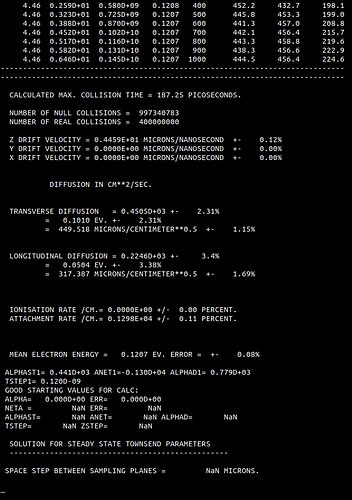Hello, I have been trying to perform some simulations of electronic transport parameters in air. First I would like to start with dry air. The code I am using is quite similar to the one in Garfield’s examples. It is attached below:
#include <iostream>
#include "Garfield/MediumMagboltz.hh"
#include "Garfield/FundamentalConstants.hh"
using namespace Garfield;
int main(int argc, char * argv[]) {
const double pressure = AtmosphericPressure;
const double temperature = (273.15 + 20);
MediumMagboltz gas;
gas.SetComposition("N2", 75.5392, "O2", 23.1781, "Ar", 1.2827);
gas.SetTemperature(temperature);
gas.SetPressure(pressure);
gas.EnableThermalMotion(true);
gas.SetFieldGrid(100. , 20000., 1000, true);
gas.GenerateGasTable(10);
gas.WriteGasFile("Air_20C_760mmHg_NoHumid.gas");
}
However, when the electric field is low (<1000 V/cm, approximately) I get a message from which the program does not progress. I attach below the message:
This happens with Magboltz version 11.11 (not with version 11.9). However, in this version the attachment coefficient is not null (something that happens in version 11.9) and I think it describes better its behavior. However, due to the above mentioned problem I am not able to do a complete simulation.
I am not sure if the problem comes from my code or the latest version has a bug.
Thanks for your help !
